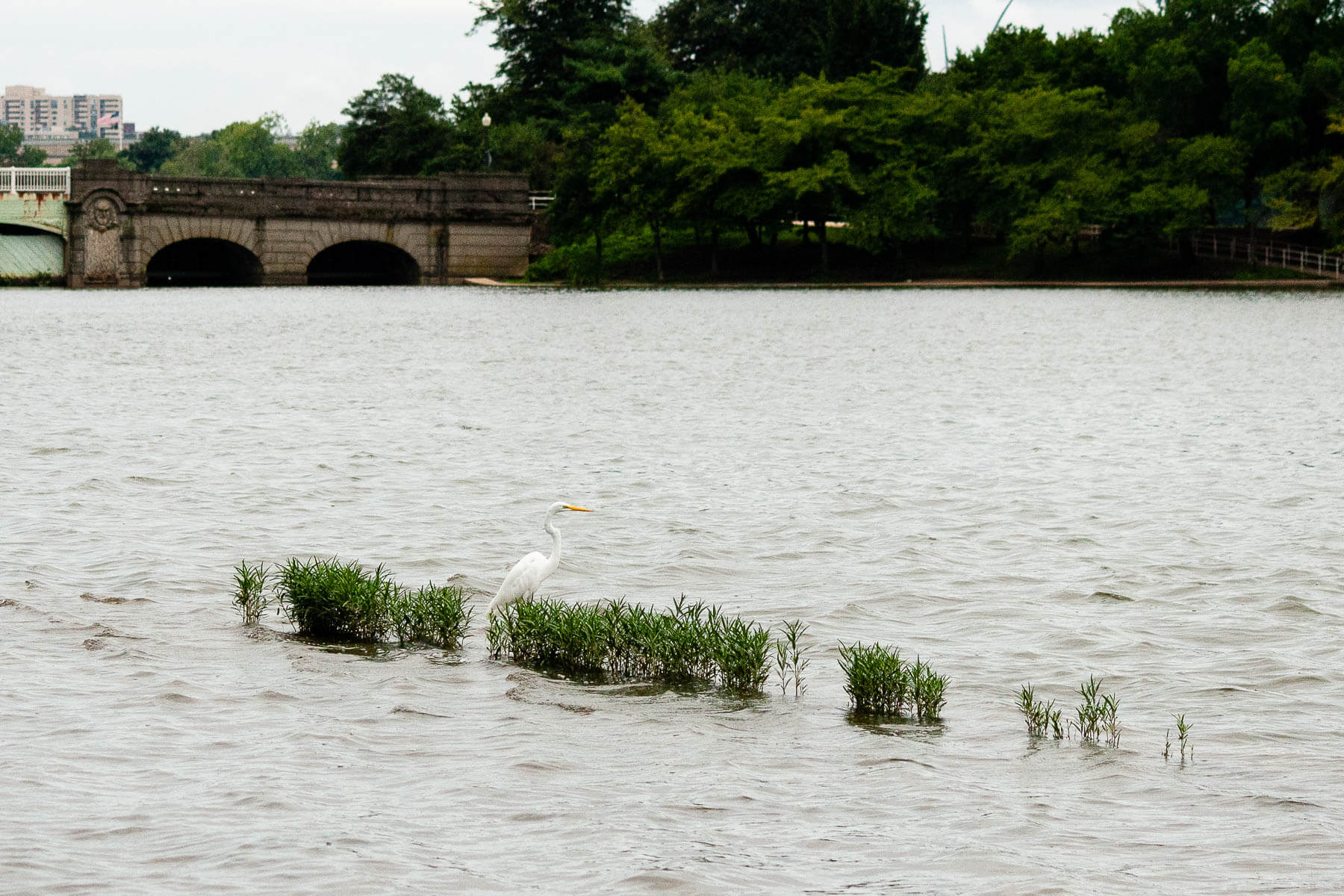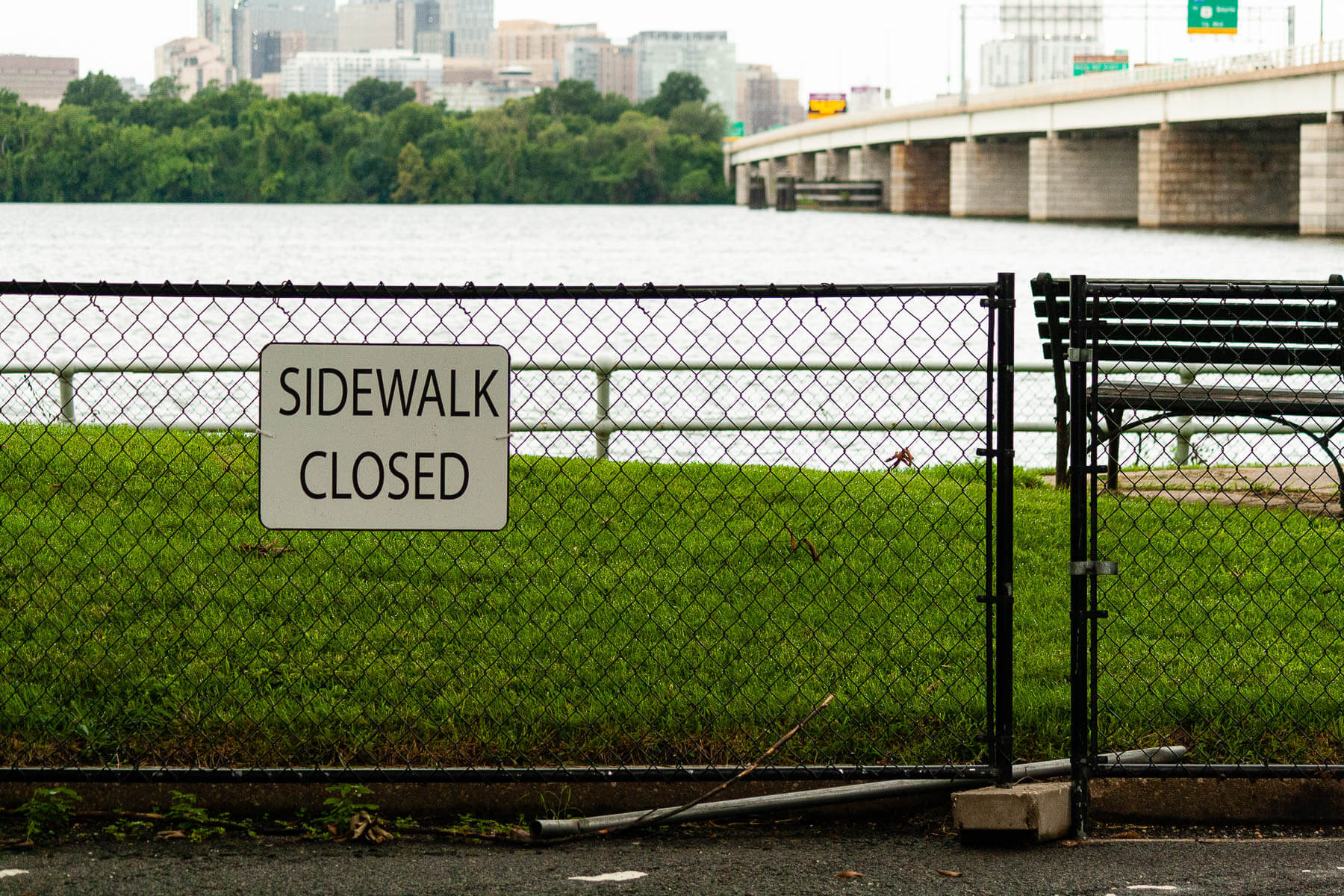Moving one step closer to reducing flooding in D.C.’s Tidal Basin

In Washington, D.C., the Tidal Basin, a historic site known for its many monuments and over 3,000 cherry trees, floods twice a day every day during high tide, due to increased water levels and deteriorating seawalls.
The basin is home to many monuments including the Jefferson Memorial, Martin Luther King Jr. Memorial and Franklin Delano Roosevelt Memorial. Each spring, over 36 million people visit the 107-acre site during the four weeks of peak cherry blossom blooms.
Seawalls, which are structures created to protect land from erosion and flooding, were built in the 1880s and create the basin. Some sections were rebuilt in the 1930s and 40s, but many areas are deteriorating. On top of their age, the seawalls have sunk roughly three feet because they were built on dredged material, not bedrock.
Compounded with climate change raising waters in the Potomac River—almost 11 inches in the last 90 years—paths flood with regular tides, threatening the health of trees and monuments and forcing visitors to find detours along the trail.
Now, after years of discussion, the National Park Service (NPS) has started the planning process to repair and raise portions of the seawall. The goal is to help create a Tidal Basin that is more resilient to climate change to ensure it can withstand not only current water levels, but also the higher waters expected decades from now.
.png)
Addressing old infrastructure
The plan is to repair and raise 6,800 feet of seawall roughly five feet making sure the walls are sunk to bedrock so they cannot settle and sink with time.
Mike Litterst, NPS chief of communications for the National Mall and Memorial Sites, said this project will be a long process and is correcting an issue that has been a NPS priority for the last 30 years.
“On a scale of one to 10, this one’s 250,” Litterst said. “It's a project that a lot of people, myself included, never thought we would work long enough to see it take place because it is such a massive and expensive undertaking.”
NPS awarded a 5.7 million dollar contract with funds from the Great American Outdoors Act for the planning process. The four-month site assessment started in spring 2022 and a 13-month environmental assessment is projected to be finished in the middle of 2023. Then, if all goes to plan, contracting and building could begin in 2024 or 2025.
The seawall rehabilitation project is currently budgeted at $120 million, but total repairs of the entire area are estimated at over $500 million.
Re-envisioning the Tidal Basin
A parallel project, the Tidal Basin Ideas Lab, was designed to re-envision the entire basin and address more than just flooding. The Ideas Lab started in 2017 and is a partnership between the National Trust for Historic Preservation, Trust for the National Mall and NPS.
With proposals from five architectural firms, as well as community member feedback, the organizations created an Ideas Lab Key Themes document that is meant to guide the vision of the revamped Tidal Basin.
The five firms pitched their plans in the fall of 2020 and while some ideas offered moderate adjustments and changes, others were complete overhauls and included moving monuments, building a jetty, creating islands and constructing raised bridges and boardwalks to protect landmarks and create a better experience for the public.
Two firms even proposed options where flooding was totally embraced with monuments protected by or sitting on islands that could be viewed through boat tours or on raised pathways over the water.

Seri Worden, senior field director for the National Trust for Historic Preservation, said she sees the Ideas Lab as something that will be a resource as plans and construction move forward in the Tidal Basin.
“We always saw it as something that would live on as the formal review process would begin for any changes,” Worden said. “[The firms were asked] to think big and think creatively in order to initiate conversation among stakeholders, the public and elected officials about problems with the Tidal Basin and potential solutions.”
Community feedback on the Ideas Lab was also encouraged and over 1,000 people responded to surveys on the Ideas Lab website in a span of four months.
According to the survey, 455 people noted that the strategy that appealed to them the most was “creating wetlands and marshes to restore the ecology of the landscape and creating flood protection.” The next highest response from 248 people was to move the cherry trees to higher ground and then 143 responses called for the natural landscape to remain unchanged.
Litterst said the cherry trees in areas that flood regularly are endangered because they are not able to tolerate the large amounts of brackish water that flow over their roots each time the tide rises. Three years ago, NPS had to remove 14 trees and will not be replanting until the flooding is stopped.
Survey respondents were able to choose from multiple choice options and provide comments about what they felt was important for restoration. One respondent wrote on a survey, “If we honor the past by stone structures only, we miss the bigger picture. We must honor the environment (water, native plantings, insects & pollinators) in order to have a complete picture of this area.”
Creating a climate resilient area
Climate change has created more frequent and severe weather events, extreme temperatures and rising sea levels across the globe, and coastal communities are seeing some of the most direct effects with increased flooding.
According to a National Oceanic and Atmospheric Administration report from 2019, high tide flooding events where water levels rise more than half a meter (20 inches) above the normal high-tide mark, are affecting the U.S. East and Gulf coastlines at upwards of twice the national rate.
The increase of flooding events can damage infrastructure and have economic impacts ranging from transportation delays, business closures and decreased tourism.
Without flood management efforts, the national frequency of high tide flooding events is expected to increase two to three times 2019 levels (7-15 days) by 2030. In 2050, the frequency of flooding events is expected to be five to 15 times higher with a median of 25-75 days of high tide flooding in a year.

To try and reduce the amount of flooding events and their impacts, creating climate resilient areas has become an important factor to coastal planning. According to the Center for Climate and Energy Solutions, climate resilience is the ability to prepare for, recover from and adapt to the effects of climate change.
Zoe Johnson, installation and community planning liaison officer for Naval Support Activity Annapolis, works on climate change and resilience issues for infrastructure projects as well as resource planning for the Naval Academy. She said two ways to help make areas more climate resilient are implementing green and gray infrastructure.
“There are a lot of benefits to the green infrastructure, and it can be cheaper,” Johnson said. “It's better for the environment. However, it's not suitable in all circumstances… and oftentimes you use them [green and gray infrastructure] in combination.”
Examples of gray infrastructure are seawalls or dams while green infrastructure uses natural solutions, such as a living shoreline, offshore natural breakwater or vegetated buffer to dampen wave energy or slow storm surge.
At the Tidal Basin, three green infrastructure solutions proposed from the Ideas Lab included creating tidal marshes, restoring wetland areas and creating a floodplain forest area. These areas would provide critical habitat for animals while helping slow the speed of flood waters. It is estimated that one acre of wetlands can absorb roughly one million gallons of water.
Looking forward
Litterst said he could not say yet what green infrastructure ideas might accompany the gray infrastructure fix of the seawalls. He said the planning and environmental assessment process will look at options in the coming months.
“We don't just want to fix the problem as it exists, we want to take a look down the road,” Litterst said. “We want to make sure that we don't have a repeat of the problem, so the design will include those elements [green construction] to make this more sustainable.”
NPS presented the rehabilitation plans for the seawalls at a virtual public scoping meeting in July 2022 and are seeking public comment until September 12, 2022.
Litterst said involving the public in any projects they work on has always been a key tenet of the NPS and is the way they can gauge interest in projects and maybe even see ideas they had never thought about before.
“We're not owners of these lands outright, we're stewards of them on behalf of the American people,” Litterst said. “If people have comments or thoughts about how these areas should be managed, or suggestions for how they should be cared for, we certainly want to hear from people.”
Now it’s a waiting game. At the earliest, construction on the seawalls would start in 2024, so it may be a while longer until people can walk the paths again without taking detours to avoid puddles, mud and flooded areas.

Comments
There are no comments.
Thank you!
Your comment has been received. Before it can be published, the comment will be reviewed by our team to ensure it adheres with our rules of engagement.
Back to recent stories